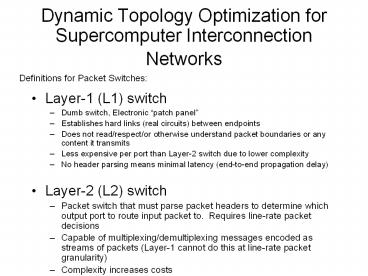Dynamic Topology Optimization for Supercomputer Interconnection Networks - PowerPoint PPT Presentation
1 / 4
Title:
Dynamic Topology Optimization for Supercomputer Interconnection Networks
Description:
... hard circuits -- contributing virtually no latency to switch fabric (propagation ... ( getting 90% of the way to all-optical switching fabric! ... – PowerPoint PPT presentation
Number of Views:168
Avg rating:3.0/5.0
Title: Dynamic Topology Optimization for Supercomputer Interconnection Networks
1
Dynamic Topology Optimization for Supercomputer
Interconnection Networks
Definitions for Packet Switches
- Layer-1 (L1) switch
- Dumb switch, Electronic patch panel
- Establishes hard links (real circuits) between
endpoints - Does not read/respect/or otherwise understand
packet boundaries or any content it transmits - Less expensive per port than Layer-2 switch due
to lower complexity - No header parsing means minimal latency
(end-to-end propagation delay) - Layer-2 (L2) switch
- Packet switch that must parse packet headers to
determine which output port to route input packet
to. Requires line-rate packet decisions - Capable of multiplexing/demultiplexing messages
encoded as streams of packets (Layer-1 cannot do
this at line-rate packet granularity) - Complexity increases costs
- Delays packets due to buffering, packet header
parsing, routing decisions.
2
Hybrid Interconnect
L1 crossbar connects NICs on nodes (P1-Pn) to
Layer2 switch ports (SW1-SWm) L1 crossbar also
connects layer 2 switch ports (SW1-SWm) to each
other to form custom topological neighborhoods.
Dynamically provisions custom interconnect
topologies on a per-job basis.
Layer-1 crossbar (electronic patch panel)
Layer-2 switch blocks
Nodes
P1
SW1
P2
SW2
P3
SW3
P4
SW4
- Lower Cost (L1 is less expensive lower L2
costs with low port counts) - Lower Latency (L1 contributes little latency)
- Improved Fault Tolerance / Fault Recovery
- Optimal Scheduling (eliminate job fragmentation
of SW topology) - Better Shelf Life (L1 switches are usable for
several generations of L2 switch technology)
3
Hybrid Interconnect (details)
- Lower Cost
- L1 switches cost a fraction of L2 per port
- Design allows bias towards cheaper,
low-port-count L2 switches. - L2 switch infrastructure costs can scale linearly
with system size (eg. provision optimal mesh
topology for each application) - Lower Latency
- L1 switches form hard circuits -- contributing
virtually no latency to switch fabric
(propagation delay due to speed of light) -- L2
stage delays are larger due packet header
parsing. - L1 light path for MEMs based optical switches
requires no OEO conversion! (getting 90 of the
way to all-optical switching fabric!) - Goal single L2 switch hop for any p2p message
- Fault Tolerance
- Lock out failing L2 switch blocks (in torus or
mesh, failures induce significant runtime
performance hit) - Optimal Scheduling (eliminate job fragmentation)
- Prevents fragmentation of the network topology
jobs are scheduled that do not fit into available
dense slots in the network topology (as much a
problem for fat-tree as it is for mesh/torus
ORNL Altix example) - Optimal mesh topology can be provisioned for each
job regardless of current system state - Better Shelf Life
- Same L1 crossbar switch can be used for multiple
generations of L2 switch implementations
4
Investigation Plan
- Analyze communication topology requirements of
existing DOE applications - Collaboration with Jeff Vetter (ORNL) to capture
communication requirements - Use captured communication requirements to define
proper balance between L1 and L2 switch layers - Use cost model for existing L1 and L2 switch
components to predict cost benefits for hybrid
infrastructure - Develop communication performance models for
specific codes to predict benefits for
lower-latency interconnects - Collaboration with UIC/StarLight facility to test
using their Glimmerglass optical crossbar
switches.































